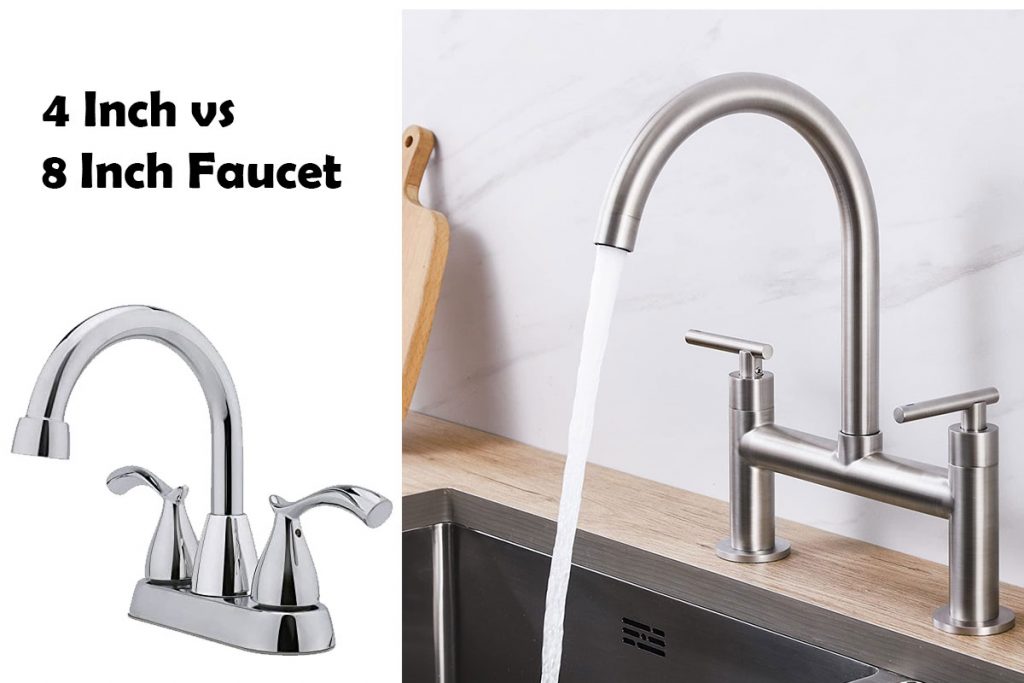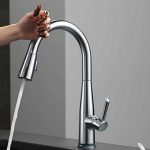Maybe you think choosing a faucet for your sink is easy. However, when going to the hardware store, you may change your mind when encountering 4-inch and 8-inch faucets
Are you currently contemplating between a 4-inch and an 8-inch faucet?
A 4-inch faucet is the perfect choice for smaller sinks, as it offers an ideal fit and is available in either centerset or mini widespread designs. On the other hand, 8-inch faucets are specifically designed for larger sinks, providing ample coverage, and are typically found in widespread designs. It’s worth noting that both types of faucets, regardless of size, can be equipped with either single or double handles, allowing for convenient control of water flow and temperature.
Keep reading to explore the variances and make an informed decision on selecting the perfect faucet that complements your bathroom style!
The Difference Between 4 Inch vs 8 Inch Faucet

Distance Of The Outer Holes
When your old tap is faulty and needs to be replaced with a new one, you have to take a faucet that is suitable with the pre-drilled hole in your sink.
If the pre-drilled outer hollow in your sink is 4-inch, you can choose a 4-inch centerset faucet or a mini widespread one.
And, if the pre-drilled outer hole measures 8 inches, an 8-inch faucet will be the best choice.
The Size Of Your Bathroom/Kitchen
Generally, a 4-inch faucet is suitable for a small bathroom or kitchen with a limited installation because it doesn’t need a large footprint.
You can use two types of 4-inch faucets if the size of your bathroom is modest: a 4-inch centerset faucet or a 4-inch mini widespread one.
Just by looking at the name, you also can know that an 8-inch faucet is much more appropriate for the spacious countertop than the 4-inch one.
Assuming that you still use the 4-inch faucet for the large sink, it might be swallowed up and looks tiny. Instead, an 8-inch faucet blends in and appears like a perfect missing piece in a large space.
The Spout & Handle Design
The 4-inch model includes two types of design of spouts and handles. The first category comes with a pre-attached spout and handles – a centerset faucet. You can choose the centerset one with single handles or double ones.
This design creates a neat and compact cover for the faucet, attracting buyers, especially people with cramped kitchens and seeking small things.
The second category is a 4-inch mini widespread faucet with double handles. This product is sold in three discrete pieces.
Meanwhile, the 8-inch faucets are composed of three individual pieces, like the widespread mini one. They will work in your sinks with three hollows 8 inches apart, within the double handles.
The hot and cold handles are not dependent on the spout. The distance of these parts is about 6 inches apart. This design is appropriate with large sinks.
To sum up, you can see all the differences between the two sizes of faucets in the table below:
| 4-inch faucet | 8-inch faucet |
| 4 inches between outer holes | 8 inches between outer holes |
| Perfect for small sinks | Perfect for double, large sinks |
| Single or double handles | Double handles |
| Spout and handles are attached | Spout and handles are separated |
| Centerset faucet or mini | Widespread faucet |
| widespread faucet |
Which Faucet Should You Select?
When choosing between a 4-inch faucet and an 8-inch faucet, you have to notice two considerations that can help you choose the most suitable for your sink. They are the compatibility of the faucet with your sink plus its size and configuration.
Choosing faucets, you have to make sure that the size of your sink fits with the faucet you pick. It will be best to identify the number of holes in the deck because it will show you which one you need – a 4-inch or an 8-inch faucet.
If you don’t replace only the faucet but buy a new sink, at this time, you have to consider the whole space. The 4-inch faucets are a great match for small sinks and tight kitchens/bathrooms.
The main issue with these small-sized faucets is the difficulty in cleaning the surrounding space. This minus point doesn’t happen with 8-inch models because they are larger.
See more: What Size Are Kitchen Faucet Connections
How Can I Know What Size Of Faucet I Need?
You have to clarify what kind of faucet you want before buying it. We will suggest some questions which you can ask yourself to solve any uncertainties:
What design do you want for your faucet?
If you prefer a faucet that has an attached spout and handles already, a 4-inch faucet is definitely your best choice. In contrast, your favorite is a faucet with expansive separate spouts and handles? Then the 8-inch design is the way to go.
Is your bathroom/kitchen small or big?
If your bathroom/kitchen is spacious, you can choose whatever you want, depending on your hobby. But we suggest that an 8-inch faucet is still a superior option. However, in case the space is not that big, a 4-inch faucet may do the trick.
How far pre-drilled holes exist in your sink are apart?
If these holes sit 4″ apart, choose a 4-inch faucet. Otherwise, please stick to an 8-inch faucet.
Frequently Asked Questions (FAQs)
Can an 8-inch faucet be used on a 4-inch spread?
No, it is not typically recommended. You can use a 4-inch faucet on an 8-inch spread by utilizing a cover plate and drilling additional holes if necessary. However, attempting to install an 8-inch faucet on a 4-inch spread might pose challenges. While it may be possible to drill new holes for the installation, feasibility depends on the specific sink and faucet configuration.
Conclusion
We have provided a detailed comparison between a 4 inch vs 8-inch faucet. Some tips to choose between two kinds of faucets are also revealed.
We hope you can find your faucet depending on our advice. If you have any questions, don’t hesitate to reach out to us.




